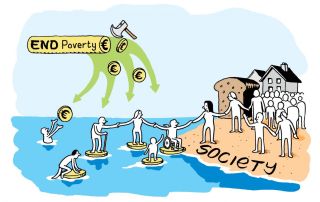Effects of Child Poverty are deep and long-lasting

In 1998 Felitti et al published the seminal research on ACEs entitled ‘Relationship of Childhood Abuse and Household Dysfunction to Many of the Leading Causes of Death in Adults. The Adverse Childhood Experiences (ACE) Study.’. Their research concluded that there was a ‘strong graded relationship between the breadth of exposure to abuse or household dysfunction during childhood and multiple risk factors for several of the leading causes of death in adults’. The study was based on a physiological examination of the subjects and a questionnaire about the respondents childhood experiences of abuse (psychological, physical and sexual) and household dysfunction (exposure to substance abuse, mental illness, domestic violence and criminal behaviour). These seven categories of childhood exposure to abuse and household dysfunction were then collated with a health questionnaire and 10 risk factors were chosen which contributed to the leading causes of morbidity and mortality in the US. There was a high level of probability that those who experienced one type of ACE experienced two or more (40-74%).
According to the Center for Youth Wellness in San Francisco, ACEs affect 34.8 million children in the United States and not only affect brain development, but can change a child’s hormonal system, immune system and DNA. The more ACEs a child is exposed to, the greater the risk of experiencing toxic stress, from high levels of the stress hormone cortisol in the blood, which in turn can increase the likelihood of chronic diseases such as asthma, heart disease and cancer. Through screening for ACEs, the Center can then provide children and their families with the necessary wraparound supports to undo existing harm and prevent the future impacts of toxic stress.
A report earlier this year from Temple Street Children’s Hospital stated that homeless children were presenting with ‘varied and complex’ issues which "in the majority…stem from the fact that these children are living in completely unsuitable, cramped and temporary accommodation”. A report published by Focus Ireland last year spoke of young families attempting to transition from temporary emergency accommodation facing “unique and potentially overwhelming obstacles”. Participants in this study tended to live at home in overcrowded accommodation, or in care, and there were families who had experienced multiple adversities including substance abuse, the death of a parent or mental illness. Difficulties in accessing long-term housing, experiences of discrimination and the insecurity of tenure also contributed to parental stress.
Adverse Childhood Experiences are experienced across all socioeconomic groups, however families in poverty are less likely to be able to access the necessary treatments to reverse the harm caused. There are currently 230,000 children living in poverty in Ireland, 4,000 are homeless. If these children are not adequately supported, the experiences they have now could shape their future health and wellbeing, and could even go so far as to alter their DNA, creating a genetic predisposition to chronic illness that can be passed to their children and their children’s children.
This is the legacy Government will leave to this and future generations if policies are not implemented to address child and family poverty. In our Poverty Focus, Social Justice Ireland recommends the following actions to address child poverty:
- Maintaining adequate adult welfare rates is vital to ensure that low income families do not fall below the poverty line.
- Child benefit remains a key route to tackling child poverty, especially for those families on the lowest incomes. It is also a very effect component in any strategy to improve equality and childcare.
- Decent rates of pay and conditions are extremely important to support working parent. Individuals working full time should be able to earn enough income to provide a decent standard of living for their families – a minimum acceptable standard of living.
- Many working families on low earnings struggle to achieve a basic standard of living. Making tax credits refundable is an efficient and cost-effective solution to help working families on low earnings.
Eliminating child poverty should be a top priority for Government. It can be done, but it requires action now.